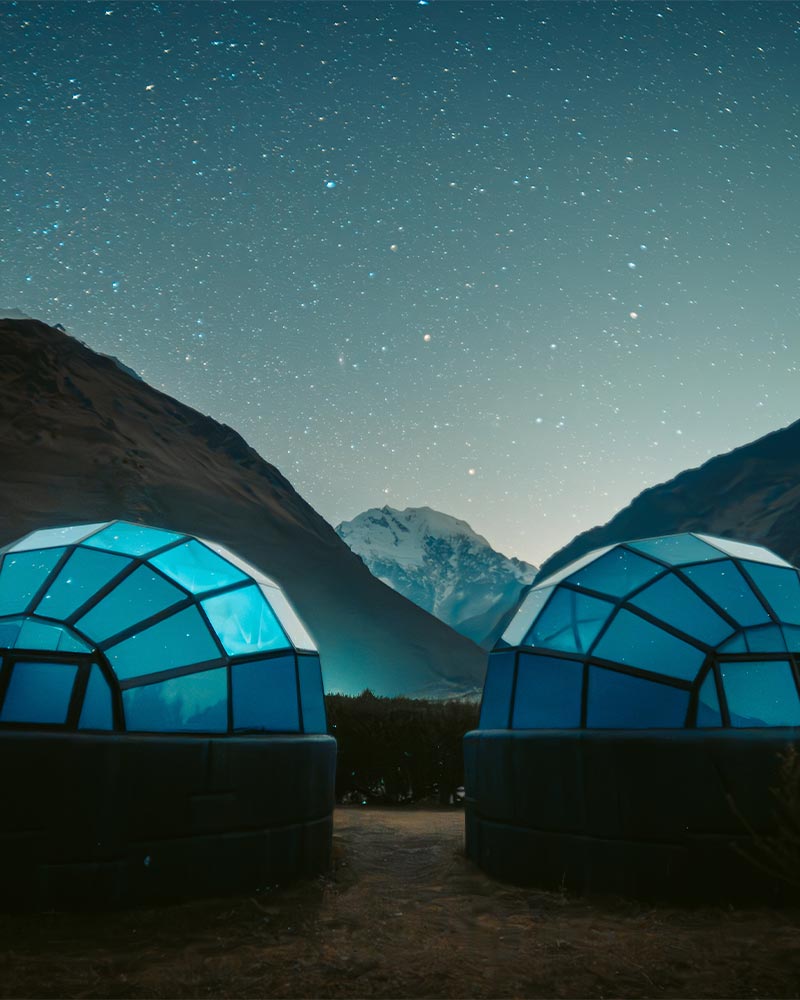What is the Best Time To Do the Salkantay Trek?
The best time of the year to enjoy the Salkantay Trek and make the most of the best weather conditions is between April and October. These months correspond to the dry season, so the sky is usually clear and there’s a lower chance of rain. However, this period also coincides with the high tourist season. That’s why we recommend choosing April and May, or September and October, when there are fewer visitors and the weather remains pleasant with little rainfall.
On the other hand, many travelers prefer to plan their trip around Cusco’s cultural events, and June is the best month of the year for that. During this time, the imperial city comes alive with traditional celebrations and the breathtaking Inti Raymi festival, an Inca ceremony that will leave you speechless. Keep in mind that Cusco can be more crowded during this season, so it’s essential to book hotels, restaurants, and tours in advance.
Keep reading to discover a detailed description of the dry and rainy seasons throughout each month of the year along the Salkantay route. This way, you’ll be able to plan your Salkantay Trek to Machu Picchu in the best possible way and make the most of your experience.
Salkantay Trek in Rainy Season: What to Expect?
What if you travel during the rainy season? It’s not the end of the world! Each season has its positive aspects. During the rainy season in Cusco, the landscape becomes much greener, rivers and lagoons reach their peak beauty, and the trails are less crowded. However, rain showers can occur at any time.
Along the Salkantay Trek, the weather is always unpredictable, but during the rainy season it’s essential to be well prepared. We recommend carrying a rain poncho or waterproof jacket in your backpack, as well as water-resistant trekking pants and boots. Even so, keep in mind that there may be days without a single drop of rain and with bright sunshine.
It’s important to note that January and February are the rainiest months along the route, and many trekking agencies choose not to operate during this period. Additionally, the Inca Trail is closed in February due to maintenance work and the risk of landslides.
Below, you’ll find detailed information about what to expect during the rainy season in each month of the year.
Salkantay Trek in November
November marks the end of the dry season in Cusco. The fields look dry and dull, but the rains are about to begin. Although they’re not very frequent yet, the further into the month you go, the higher the chances of rain during the trek. Even so, temperatures are generally pleasant, and for most of the route, you’ll warm up easily.
Salkantay Trek in December
This month marks the beginning of summer throughout Peru, and many domestic tourists take the opportunity to go on vacation. The temperature remains warm (between 20 °C and 7 °C, or 68 °F and 44.6 °F), but rain will be constant. Even so, it’s a good time of year to travel, as you won’t encounter crowds. We just recommend bringing the proper waterproof gear.
Salkantay Trek in January
January is the wettest month of the year, and the sun will appear less frequently. It’s likely to rain daily during this time, although the showers usually don’t last long. Even so, you’ll still enjoy some sunshine throughout the day, which helps the trails dry quickly.
Salkantay Trek in February
February is the rainiest month on the Salkantay route, and it’s common to find slippery ground. If you decide to travel during this season, make sure to bring waterproof clothing and hiking boots with good traction to avoid falls.
Remember that at Salkantay Trekking, we pause our operations during the month of February to rest and continue training our team. Keep this in mind before making your reservation.
Salkantay Trek in March
Heavy rains continue throughout the month of March, but longer breaks between clouds begin to appear, allowing the sun to shine more often. The Salkantay route starts to dry out, and little by little, more visitors return. That’s why it’s important to bring the right gear to keep yourself dry and safe during the trek.
Salkantay Trek in April
In this month, the rains begin to fade and the days become more stable. Although April is still considered part of the rainy season, rainfall is much less frequent and generally brief. The sun starts to shine more strongly, allowing you to enjoy the landscape in all its splendor, with mountains covered in vegetation. Also, since it’s not high season, you’ll find fewer people on the trail, making your experience more peaceful and special.
Salkantay Trek in Dry Season: What to Expect?
The dry season in Cusco is known for its sunny days and the chance to enjoy the most stunning views of the Andean landscapes under clear skies. However, this pleasant weather also attracts many visitors looking to take advantage of the dry conditions. Therefore, during these months, it’s likely you’ll encounter several people doing the Salkantay Trek.
You’ll also need to be well equipped for the dry weather. Mornings and nights can be very cold, so it’s important to bring warm clothing. On the other hand, the sun shines strongly during the day, and temperatures can become quite hot. At the high altitude of the Andes, solar radiation is intense and can be harmful to your skin. That’s why you should always carry sunscreen and a cap or hat to protect yourself from the sun.
As mentioned earlier, planning is key when traveling during the dry season, as demand is high and availability can be limited if you don’t book in advance. Make sure to secure your spot on the trek and at your preferred accommodations. We recommend making your reservations at least three months in advance.
Below, we provide a breakdown of each month during the dry season on the Salkantay route, so you can plan your adventure optimally and make the most of your experience.
Salkantay Trek in May
Great! The dry season has officially begun. Although you might still encounter some rain, it will be brief and light. Overall, rainfall has decreased significantly and the weather is delightful at this time of year. It’s an ideal moment to hike the Salkantay route before the big crowds arrive.
Salkantay Trek in June
June is the driest month of the year, and rain is almost nonexistent along the Salkantay route. However, it coincides with the Andean winter, so nighttime temperatures can drop below 0 °C (32 °F), especially at higher points and at our Soraypampa campsite, near the Humantay Lake. During the day, the weather is pleasant and warm, with temperatures around 20 °C (68 °F).
Keep in mind that in June, Cusco celebrates its anniversary, which attracts many visitors. Therefore, you’re likely to find more people both in the city and along the route.
Salkantay Trek in July
In July, the nights are even colder, so it’s essential to have a proper sleeping bag and warm clothing to sleep at Soraypampa. During the day, the sun shines strongly, especially around noon. We recommend using high-SPF sunscreen to protect your skin from radiation.
This month also includes Peru’s Independence Day celebrations, which keep Cusco and the Salkantay route quite busy. Although July is part of the dry season, occasional frosts or hailstorms may occur due to the intense cold.
Salkantay Trek in August
Winter is coming to an end, but temperatures in the high areas of the Salkantay trek remain cold at night. The days gradually become warmer, and rainfall continues to be scarce.
August is still a month with high tourist traffic and offers spectacular views with clear skies along the route. However, the landscape starts to look drier as the season progresses.
Salkantay Trek in September
September is an excellent time of year to do the Salkantay trek. Temperatures begin to rise and there are only occasional light showers. You’ll feel warm during the day and be able to enjoy the Andean sun and spectacular views. Although there are still tourists around, the crowds are smaller compared to the busiest months. Without a doubt, it’s an ideal time to visit Machu Picchu.
Salkantay Trek in October
October is the warmest month of the year on the Salkantay trek. It’s an excellent time to travel and make the most of the good weather, while also avoiding large crowds. The skies are usually blue and clear, although light rain is still possible. This is the last chance of the year to enjoy spectacular views of Salkantay and Machu Picchu before the rainy season returns.
What Is the Average Temperature of Salkantay Trek?
Daytime weather doesn’t vary much throughout the year, although during the dry season, nighttime cold intensifies considerably. At the Soraypampa campsite and in the highest sections of the trek, average temperatures reach around 20 °C (70 °F) during the day and drop below 0 °C (32 °F) at night.
As you get closer to Machu Picchu and enter the edge of the jungle, the climate becomes warmer and more humid, and the cold is no longer an issue. In this part of the route, daytime temperatures can reach up to 26 °C (80 °F).
What Is the Coldest Month in Salkantay?
During the dry season in Cusco, winter sets in between June and July, with July being slightly colder. These dates fall in the middle of the dry season, which means that nights are extremely cold, with temperatures that can drop below 0 °C (32 °F) on the Salkantay trek.
To fully enjoy this winter experience, we recommend arriving well-prepared. It is essential to have a warm sleeping bag (-15°C / 5 °F) and multiple layers of warm clothing. This way, you will be protected from the intense cold at night. However, despite the low temperatures at night, the days remain fairly warm.
Does the Weather in Salkantay Affect Flights?
When planning your trip to Salkantay, remember that there are no direct flights to the trail; all flights arrive first in Cusco. Although weather in Cusco rarely affects flights, delays may occur in cases of heavy rain or dense fog.
It’s not common, but if it does happen, airlines usually reschedule the flights or ask you to wait until the weather improves. We recommend checking the weather forecast and your flight updates through official channels before traveling.
What to Pack When Visiting Salkantay?
To have complete information on what to pack, you can check out our full packing list for the Salkantay trek. Below, we’ve included a short checklist of what you need to bring:
Clothing
- Comfortable layers to adapt to temperature changes
- Raincoat or poncho
- Warm jacket and sweater
- Pajamas
- Hat, scarf, and gloves for cold nights
- Sun hat and sunglasses
Footwear
- Waterproof hiking boots or shoes already broken in
- Sneakers
- Sandals to rest at the campsite
Hygiene and personal care
- Personal hygiene items
- Toilet paper
- Hand towel
- Insect repellent
- Sunscreen (SPF 50+)
Accessories and gear
- Daypack for your daily belongings
- Reusable water bottle
- Flashlight
- Power banks
- Camera or phone with a good camera
- Backpack lock
- Guidebook or map
Documents and other items
- Passport
- Personal medications
Plan Your Trip Now!
Our ultimate weather guide to the Salkantay trek gives you a clear overview of the best time to travel and which season best suits your preferences—whether it's avoiding crowds, enjoying nature, or steering clear of the rain.
Most tourists hike the trail between May and October, with June being the busiest month. However, we recommend considering the rainy season if you prefer a more peaceful experience. Although the number of visitors decreases during this time, the weather remains pleasant.
If you decide to venture out during the rainy season, we guarantee an incredible experience. Just ensure you are prepared for possible drizzles by bringing the appropriate gear.
No matter which option you choose, it's time to get excited! An unparalleled hiking experience awaits you on the BEST ALTERNATIVE ROUTE TO MACHU PICCHU. Get ready for unforgettable moments!













